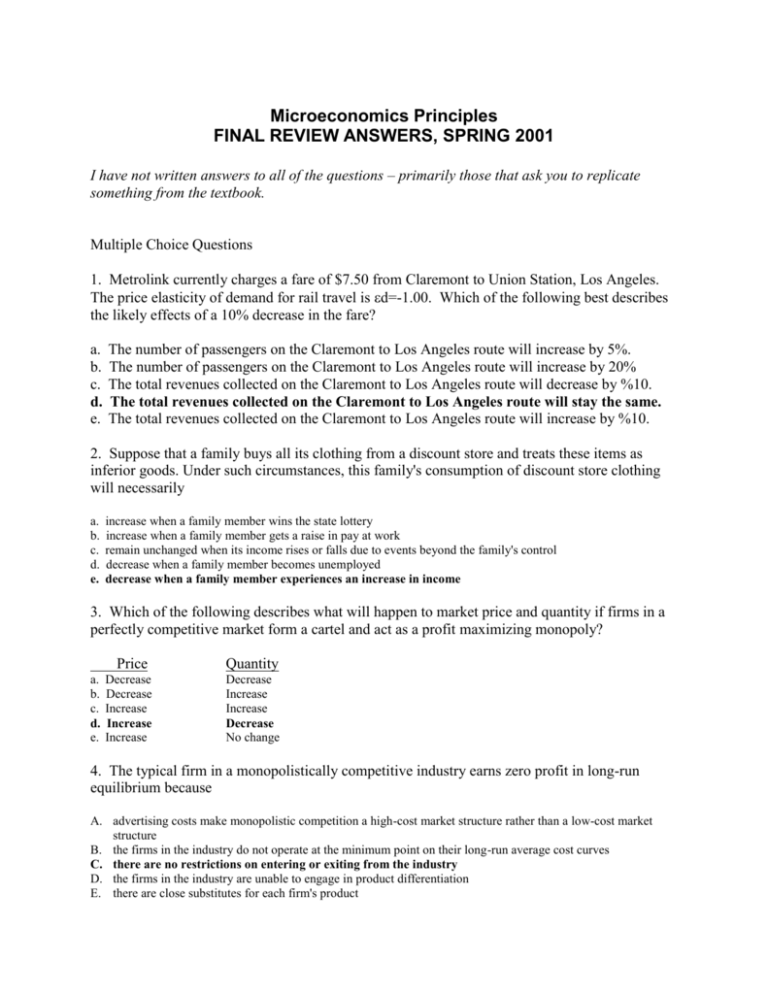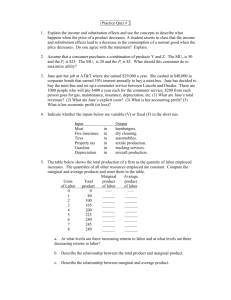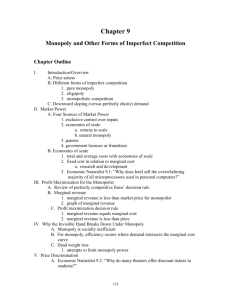review for final answers
advertisement

Microeconomics Principles FINAL REVIEW ANSWERS, SPRING 2001 I have not written answers to all of the questions – primarily those that ask you to replicate something from the textbook. Multiple Choice Questions 1. Metrolink currently charges a fare of $7.50 from Claremont to Union Station, Los Angeles. The price elasticity of demand for rail travel is d=-1.00. Which of the following best describes the likely effects of a 10% decrease in the fare? a. b. c. d. e. The number of passengers on the Claremont to Los Angeles route will increase by 5%. The number of passengers on the Claremont to Los Angeles route will increase by 20% The total revenues collected on the Claremont to Los Angeles route will decrease by %10. The total revenues collected on the Claremont to Los Angeles route will stay the same. The total revenues collected on the Claremont to Los Angeles route will increase by %10. 2. Suppose that a family buys all its clothing from a discount store and treats these items as inferior goods. Under such circumstances, this family's consumption of discount store clothing will necessarily a. b. c. d. e. increase when a family member wins the state lottery increase when a family member gets a raise in pay at work remain unchanged when its income rises or falls due to events beyond the family's control decrease when a family member becomes unemployed decrease when a family member experiences an increase in income 3. Which of the following describes what will happen to market price and quantity if firms in a perfectly competitive market form a cartel and act as a profit maximizing monopoly? a. b. c. d. e. Price Quantity Decrease Decrease Increase Increase Increase Decrease Increase Increase Decrease No change 4. The typical firm in a monopolistically competitive industry earns zero profit in long-run equilibrium because A. advertising costs make monopolistic competition a high-cost market structure rather than a low-cost market structure B. the firms in the industry do not operate at the minimum point on their long-run average cost curves C. there are no restrictions on entering or exiting from the industry D. the firms in the industry are unable to engage in product differentiation E. there are close substitutes for each firm's product 6.Which of the following inevitably causes a shift in the market demand for workers with a certain skill? a. An increase in the demand for goods produced by these workers b. A decrease in tax rates on the income of these workers c. An increase in the equilibrium wages received by these workers d. An increase in the supply of these workers e. The creation of a federally subsidized program to train new workers 7. If hiring an additional worker would increase a firm's total cost by less than it would increase its total revenue, the firm should a. b. c. d. e. not hire the worker hire the worker hire the worker only if another worker leaves or is fired hire the worker only if the worker can raise the firm's productivity reduce the number of workers employed by the firm 8. An effective price floor introduced in the market for rice will result a. b. c. d. e. a decrease in the price of rice and a increase in the quantity of rice sold a decrease in the price of rice and a decrease in the quantity of rice sold a decrease in the price of rice and an excess demand for rice an increase in the price of rice and an excess supply of rice an increase in the price of rice and an excess demand for rice 9. A leftward shift in the supply curve of corn would result from a. a decrease in the price of corn b. a decrease in the price of farm machinery c. an increase in the demand for com bread d an increase in the labor costs of producing corn e. an increase in consumers' incomes 10. The government is considering imposing a 3 percent tax on either good A or good B. In order to generate the largest revenue, the tax should be imposed on the good for which a. b. c. d. e. demand is perfectly elastic demand is perfectly inelastic demand is unit elastic supply is perfectly elastic supply is unit elastic 11. Suppose that the consumption of a certain product results in benefits to others besides the consumers of the product. Which of the following statements is most likely to be true? A. B. C. D. The demand for the product is price inelastic. A perfectly competitive industry will not produce the optimal quantity of the product. A perfectly competitive industry will not produce the product. Optimality requires that consumers of this product be taxed. E. Producers of this product earn an economic profit. 13. A city council is deciding what price to set for a trip on the city's commuter train line. If the council wants to maximize profits, it will set a price so that A. B. C. D. E. price equals marginal cost price equals average cost price equals marginal revenue marginal revenue equals marginal cost marginal revenue equals average total cost 14. Which of the following best describes the difference between long run equilibrium under monopoly and under monopolistic competition? a. Under monopolistic competition, price = marginal cost but under monopoly price > marginal cost. b. Under monopolistic competition, price is greater than marginal cost but under monopoly price = marginal cost. c. Under monopolistic competition, price is equal to average total cost but under monopoly, price is greater than average total cost. d. Under monopolistic competition, price is equal to marginal revenue, but under monopoly price is greater than marginal revenue. e. Under monopolistic competition, output is produced where average total cost exceeds marginal cost, but under monopoly, output is produced where average total cost equals marginal cost. Other Questions 1) a) The balloon industry is perfectly competitive industry and in long run equilibrium. Use a graph to illustrate i) industry price and output; ii) the demand curve facing a typical firm in the industry; iii) the output of a typical firm; iv) profits of a typical firm. MC D S ATC P Firm Demand q Q On my graph, industry price is $42; industry output is 355. A typical firm produces where MC and ATC intersect (2.4 units approx.) and earns zero economic profits. (BE SURE TO MARK YOUR OUTPUT ON YOUR GRAPH. ) b) A decline in the birth rate reduces the number of children's birthday parties. Use your graph to illustrate the short run effect on i) market demand; ii) market supply; iii) industry output and price; iv) the demand curve facing a typical firm in the industry v) the output of a typical firm; vi) profits of a typical firm. MC ATC New firm D New D New q The decrease in birth rates reduces demand for balloons. Demand shifts down to the left. The equilibrium price will be lower (approximately $32 in my graph). Industry output decreases to 300 units. The firm will respond to this lower price by reducing output to where the new price intersects MC. At this output, the firm is losing money. c) Use your graph to explain the long run impact of the decline in the birth rate on i) market demand; ii) market supply; iii) industry output and price; iv) the demand curve facing a typical firm in the industry; v) the output of a typical firm; vi) profits of a typical firm. In the long run, firms will want to exit this industry. Exit will shift supply up to the left. As supply decreases, the market price will increase. A new equilibrium will have price equal to the original price. (The firm’s demand will shift up.) Each firm will produce its original input, but because there are fewer producers industry output will be smaller. Each firm will earn zero economic profit. New Supply Firm demand New LR Equil q New LR Equil. Q 2) Monopolies will pass on the 100% of the burden of a $1 per unit sales tax to their customers. True, False or Uncertain. Marginal Cost + Tax Demand Marginal revenue Q2 Q1 False. In the diagram above, the tax increases the marginal cost of production for the monopolist. The initial price and output is $6 and 4 units. After the tax, output falls to 3 units and price increases to $7. The price increase is less than the full amount of the tax. Hence, producer profit will fall. 3) The government places a tax on the purchase of socks. a) Illustrate the effect of this tax on equilibrium price and quantity in the sock market. b) Identify the following areas both before and after the imposition of the tax: total spending by consumers, total revenue for producers, and government tax revenue. c) Does the price received by producers rise or fall? Label the old and new price received by producers on your diagram. Does producer surplus rise or fall? Show graphically. d) Does the price paid by consumers rise or fall. Label the old and new price paid by consumers on your diagram. Does consumer surplus rise or fall? Show graphically. This is a straightforward question with the diagrams in your textbook and in the lecture notes. Make sure you label your graphs completely. 4) Jennifer divides her income between coffee and croissants. An early frost in Brazil causes a large increase in the price of coffee in the United States. a) Use a graph to show the effect of the frost on Jennifer’s budget constraint and on her optimal consumption bundle. b) In words, describe the effect of this price increase on coffee consumption in terms of a substitution effect and an income effect. c) Use your graph to illustrate the substitution effect of this price increase. d) Use your graph to illustrate the income effect of this price increase. e) Under what circumstance will the price rise in coffee not cause a change in Jennifer’s consumption of coffee? Again, this is a straightforward questions. Examples of the appropriate graph can be found in your textbook. For part (e), a rise in the price of coffee will not decrease consumption if coffee is an inferior good, and the substitution effect exactly offsets the income effect. 4. Explain national defense is sometimes given as an example of a public good. Explain that national defense is nonrival, one persons consumption does not interfere with another’s consumption and nonexcludable, impossible to exclude someone once good is provided. 5. Explain what is meant by "moral hazard." Give an example. In a environment where there is asymmetric information, one party, the agent, may have an incentive to behave in a way that reduces the utility or profit of the principal. For example, if an insurance company insures your bicycle for %100 of its value, you may not lock it up. 6. Any price change has two distinct effects on the quantity demanded an income effect and a substitution effect. Use these two concepts to explain why a labor supply curve may be backward bending. The wage is the price of leisure. When the price of leisure increases, the substitution effect implies a reduction in leisure as the consumer substitutes away from the good that has become more expensive. Hence, the substitution effect implies an increase in hours work following an increase in the wage. The income effect implies that the consumer will purchase more of all normal goods since an increase in the wage increases purchasing power. Thus, the income effect implies an increase in hours of leisure and a decrease in hours worked. The two effects work against each other. If the substitution effect exceeds the income effect, the labor supply slopes up. We expect this to be true and low wages. If the substitution effect equals the income effect, labor supply will be vertical. This might be true for higher wages. Finally, if the income effect exceeds the substitution effect, the slope of labor supply will be negative – the backward bend. 7. There is considerable controversy concerning the impact of the minimum wage law on the employment of teenagers. Describe three cases where the imposition of a minimum wage will not reduce total employment. Use graphs to illustrate each case. Case I. The minimum wage lies below the equilibrium wage. Case II. The demand for labor is perfectly inelastic Case III. A monopsony (No graph required) 8. Good X is produced under conditions of perfect competition. Production of Good X unavoidably creates smoke that causes health problems for residents near the factories. a. Use a graph to illustrate that a perfectly competitive market will tend to produce too much of Good X. Show Demand (Marginal Private Benefit); Supply (Marginal Private Cost) and Marginal Social Cost on your graph. b. The President proposes a per unit tax on Good X. The proceeds of the tax would be used to finance health care for residents near the factories. Is this an appropriate government policy in this case? Use a graph to illustrate the effect of the tax on the short run equilibrium price and quantity of Good X. Who pays the burden of the tax? A tax equal to the difference between MSC and MPC will reduce output to the socially optimal level. The burden of the tax will be shared between consumers and producers. c. Assume production of Good X is characterized by constant returns to scale. What will be the effect of the tax on price and output in the long run. Who pays the burden of the tax? Explain. After the tax, the price that producer’s receive will be reduced and hence, firm profits will be lower. Assuming the market was initially in long run equilibrium, firms will have negative economic profit. Some firms will exit, shifting supply up to the left. As firms exit, the market price rises. Exit continues until price equals the new long run average total cost which is the original long run average total cost plus the tax. Hence, in the long run, consumers pay the entire amount of the tax. d. Identify one alternative approach to solving this externality problem and discuss the advantages and disadvantages of this approach as compared with a tax. You could talk about assignment of property rights or a command and control approach. 9. Under monopolistic competition, the firm will operate at the minimum point on its average total cost curve. True, false or uncertain. Explain. See chapter. 10. Figure One illustrates the demand curve for a monopoly firm. Use the graph to answer questions a-c. FIGURE ONE a Show the monopolist's profit maximizing price and output. b Use the graph to show the monopolist's profits. c Use the graph to illustrate the deadweight loss associated with monopoly power in this market. See Chapter. 11,. The following sentence contains a common error. Identify and explain. "Demand increases, causing prices to rise. Higher prices cause demand to fall. Therefore, prices fall back to their original levels." The error here is a confusion between a movement along a demand and a shift in demand. Initially, there is a shift in the demand curve. This increases the price. With the higher price, the quantity supplied increases. Hence, quantity demanded will equal quantity supply and there are no forces pushing price to decrease, ceteris paribus. 12. (President Caballero proposes a cut in the payroll tax of 10%. Using the income and substitution effects, explain how the Caballero cuts could lead to either an increase or decrease in labor supply. (Diagram is not required.) Similar to earlier question. 13. Why does the short run marginal cost curve generally slope up? The law of diminishing marginal returns. Also, the exam will include questions based on the in-class presentations since the second midterm.








